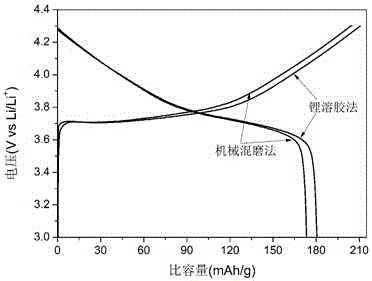Preparation method for positive electrode material of lithium ion battery
A technology for lithium-ion batteries and positive electrode materials, applied in battery electrodes, secondary batteries, circuits, etc., can solve the problems of broken precursors, low performance of electrode materials, and large destructive effects of precursors, so as to improve electrochemical performance and processability, uniform distribution of positive electrode material elements, and excellent electrochemical performance
- Summary
- Abstract
- Description
- Claims
- Application Information
AI Technical Summary
Problems solved by technology
Method used
Image
Examples
Embodiment 1
[0028] (1) Add lithium carbonate to nitric acid to dissolve, then add complexing agent ammonia water, adjust the pH of the solution to 7, and obtain a lithium salt sol with a concentration of 2mol / L;
[0029] (2) The cathode material precursor Ni 0.6 co 0.2 mn 0.2 (OH) 2 Add it to the lithium salt sol and mix it into a slurry, wherein the molar ratio of the lithium salt sol to the positive electrode material precursor is 1.02:1, and the solid content in the slurry is 60wt%. Heat and evaporate the solution while stirring to obtain a dry gel ;
[0030] (3) In air, calcinate the dried gel at 870°C for 15 hours to obtain LiNi, the cathode material for lithium-ion batteries. 0.6 co 0.2 mn 0.2 o 2 .
Embodiment 2
[0036] (1) After dissolving lithium oxide in nitric acid, further add complexing agent ammonia water, adjust the pH of the solution to 5, and obtain a lithium salt sol with a concentration of 10mol / L;
[0037] (2) The cathode material precursor Ni 0.8 co 0.15 Al 0.05 (OH) 2 Add it to the lithium salt sol and mix it into a slurry. The molar ratio of the lithium salt sol to the cathode material precursor is 1.2:1, and the solid content in the slurry is 70wt%. Heat and evaporate the solution while stirring to obtain a dry gel;
[0038](3) In the air, calcinate the dried gel at 950°C for 10 hours to obtain LiNi, the cathode material for lithium-ion batteries. 0.8 co 0.15 Al 0.05 o 2 .
[0039] Further scheme, the cathode material precursor in described step (2) is Ni x co y mn 1-x-y o 2 or Ni x co y mn 1-x-y (OH) 2 or Ni x co y Al 1-x-y o 2 or Ni x co y Al 1-x-y (OH) 2 , where 0x m 1-x o 2 or Ni x co 1-x o 2 , where M=Ni, Co, Mn, 0
Embodiment 3
[0041] (1) After dissolving lithium nitrate in water, further add complexing agent ammonia water, adjust the pH of the solution to 6, and obtain a lithium salt sol with a concentration of 0.1mol / L;
[0042] (2) The cathode material precursor Mn 0.7 Ni 0.2 co 0.1 (OH) 2 Add it into the lithium salt sol and mix it into a slurry. The molar ratio of the lithium salt sol to the cathode material precursor is 0.98:1, and the solid content in the slurry is 40wt%. Heat and evaporate the solution while stirring to obtain a dry gel;
[0043] (3) In an oxygen atmosphere, the dried gel was calcined at 800°C for 18 hours to obtain a lithium-ion battery cathode material 0.2Li 2 MnO 3 0.8LiMn 0.625 Ni 0.25 co 0.125 o 2 .
PUM
 Login to View More
Login to View More Abstract
Description
Claims
Application Information
 Login to View More
Login to View More - R&D
- Intellectual Property
- Life Sciences
- Materials
- Tech Scout
- Unparalleled Data Quality
- Higher Quality Content
- 60% Fewer Hallucinations
Browse by: Latest US Patents, China's latest patents, Technical Efficacy Thesaurus, Application Domain, Technology Topic, Popular Technical Reports.
© 2025 PatSnap. All rights reserved.Legal|Privacy policy|Modern Slavery Act Transparency Statement|Sitemap|About US| Contact US: help@patsnap.com


